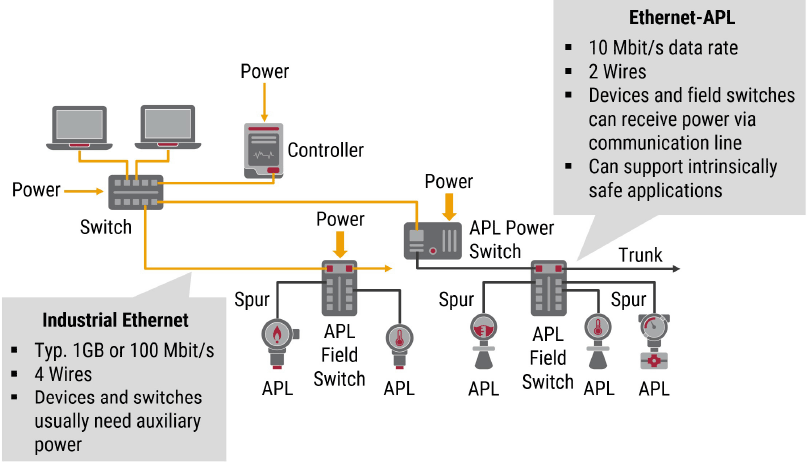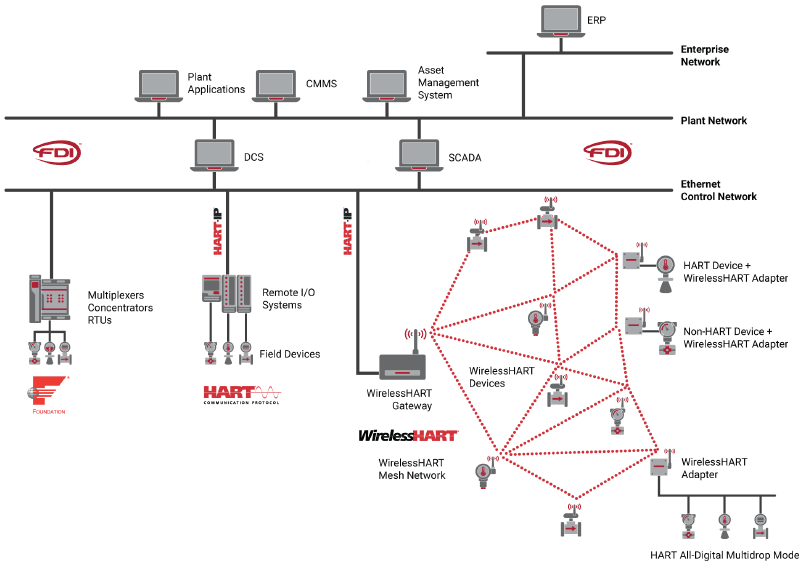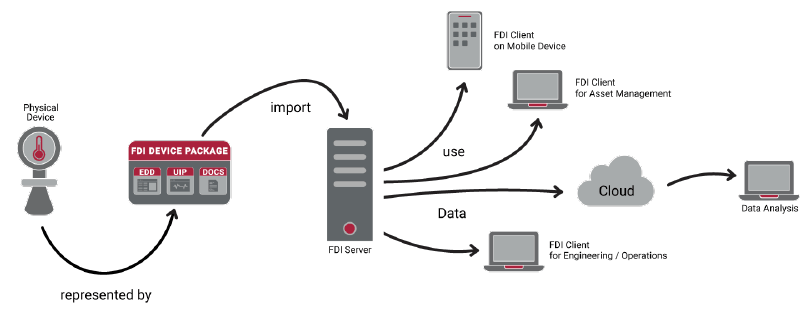- By Ted Masters, Paul Sereiko
- May 01, 2023
- Connectivity & Cybersecurity
Summary

Change is coming to process automation. Newer standards for connectivity favor the early adopters.
Change comes slowly in the process automation industry in general, particularly in process plants and facilities. Consumer product lifecycles are measured in durations as short as just a few months, and factory automation upgrades typically occur every few years to match their output to consumer demand, but a process plant often operates for decades.
Once a plant has begun operating, upgrades occur rarely, and typically only to meet a new requirement such as regulatory compliance or increased capacity. In general, the closer a piece of hardware is to the process, the more costly it is to upgrade. Thus, instruments, valves, remote input/output (I/O), and other field devices often remain in place with little change for many years. For example, upgrading an instrument with a process penetration might require cutting and welding, in addition to new wiring infrastructure, making it a costly proposition.
This phenomenon in part explains why 4-20 mA instruments, often supporting the HART communication protocol, still dominate the installed base. But it doesn’t explain why even today, 4-20 mA HART instrument devices still represent the greatest market share for new instrument shipments.
A leading reason may be that until a technology enters the market that meets the needs for both real-time control—for example by providing operational simplicity—and the asset management and maintenance teams’ desire for data, 4-20 mA plus HART is often the best option. But end users would do well to select vendors and automation system components with the future in mind. This requires understanding the progress being made toward adoption of multiple industry standards and frameworks for system development, connectivity, and communications. These and other changes also necessitate a closer bond between operational technology (OT) and information technology (IT).
In response to this need, government, user, and standards development organizations (SDOs) like FieldComm Group are active in many of these areas. FieldComm Group, for example, co-owns the Ethernet-APL, Field Device Integration (FDI), and Process Automation Device Information Model (PADIM) standards with other SDOs.
The “advanced physical layer” of EthernetAPL promises to bring high-speed, IP-enabled communications to the instrument and infrastructure network layers. Remote I/O will be replaced or augmented with Ethernet switches in many cases, and 4-20 mA field devices will be upgraded to their EthernetAPL counterparts. Ethernet-APL field devices will be connected through Ethernet switches to controllers, human-machine interfaces (HMIs), servers, and other hosts as part of the greater automation system. (Figure 1).

For large process plants, hosts often include an asset management system and a distributed control system (DCS). The DCS landscape is also facing significant change, as the Open Process Automation Forum (OPAF) aims to re-invent the controller and DCS business with an open architecture solution, removing end user reliance on proprietary vendor technology.
Widespread adoption of these initiatives will create a much higher degree of interoperability, allowing end users to pick the best-of-breed products for their applications. It will also force vendors to innovate on product features and benefits demanded by end users, instead of focusing on the development of proprietary technologies.
SDOs, and many end users, in the process automation industry are optimistic that the previously described initiatives will result in improved plant operations in the future. Vendor support varies, with some strongly supporting all initiatives and others targeting their support based on the perceived strengths of their product portfolios. End users should eventually see more open systems, and this transition can be hastened if they have a plan in place to adopt these new technologies.
Step 1: Plan and prepare
Hardware considerations. Most of the installed field device base is 4-20 mA, often with HART, and current shipments are still largely 4-20 mA, albeit with even more HART-enabled devices. But it should be clear that if a facility wants to be able to take full advantage of open systems and digitalization at any reasonable scale, it needs to start laying the foundation now for what will eventually become a modernized plant
From a physical perspective, plant personnel should initially identify high-value assets and processes that might be targeted for future digitalization, using one of two methods:
-
HART-IP gateways. 4-20 mA HART field devices often terminate at a host system that does not support the HART standard. To address this issue, several vendors offer gateway products that can capture data from multiple HART instruments, buffer the information, and then publish it over high-speed wired Ethernet using the HART-IP protocol for use by host systems.
-
WirelessHART. Virtually any 4-20 mA HART instrument can be converted to support WirelessHART with the addition of an adapter, available from many vendors. The upgraded instrument can then be connected to a WirelessHART network, and eventually to a host system via an Ethernet connection from a WirelessHART gateway. The existing 4-20 mA connection can be maintained for real-time control, with the wireless system freeing up formerly stranded data, such as secondary process variables and diagnostics, for use by host systems (Figure 2).

Figure 2: WirelessHART adapters can be used to free stranded data from 4-20mA HART instruments, and to connect non-HART 4-20mA instruments to WirelessHART networks.
It’s also worthwhile to assess which units might be undergoing a turnaround in the near term. If updated wiring infrastructure is part of the plan, users should consider selecting cables and routings that will work with future installations of Ethernet-APL devices and switches.
Software considerations. On the software side, adoption of host systems supporting modern communication technologies should be considered, as these will be required for implementing plant modernization and digitalization strategies. FDI technology, which is endorsed by end user organizations like NAMUR, has been available for several years, and most major host system suppliers support it (Figure 3).

One of the key benefits of FDI is simpler device integration with host systems, but the FDI host architecture also enables additional integration, including host-to-cloud connectivity, for example using OPC UA technology and the PA-DIM information model.
FDI implementation requires both host system and field device support. First, host system software must be FDI-enabled, so end users should seek out FDI-registered host software, available from ABB, Emerson, Honeywell, Siemens, and other vendors. Second, instruments must support the FDI device package, which is similar to a ZIP file. When imported into an FDI host, the package expands to include a driver file for the device, as well as additional files like documents and user interface plugins.
FDI device package technology now supports many features that end users have demanded in an integration solution, including:
- Device health. Advanced device health diagnostics must be supported per the NAMUR NE 107 recommendation.
- IIoT readiness. Support for PA-DIM
- Offline configuration. Standardized support for bulk configuration of instruments and systems prior to installation
- Modern user interfaces. FDI device packages from some vendors may come with a vastly improved user interface plug-in (UIP), supporting .NET or HTML5 technology.
- FDI device package security. The FDI device package ensures security because vendors and test organizations, like the FieldComm Group, must “sign” the package using a recognized certificate authority during the conformance and registration process.
Once these building blocks are in place, the next step can be taken—piloting new technologies.
Step 2: Pilot new technologies
Ethernet-APL networks will fundamentally alter the design of future process automation systems. But first, they will begin to displace existing field networks that use cabling common to FOUNDATION Fieldbus and Profibus PA, or they will be used in unit turnarounds where instrumentation and infrastructure are being replaced.
One of the key features of Ethernet-APL is the separation of the physical layer from the automation protocol, heretofore linked. This separation allows for installation of a plantwide Ethernet infrastructure that can then be used with much greater flexibility.
Since most core process instrumentation is used to measure pressure, temperature, level, and flow—and since most of these instruments currently use 4-20 mA plus HART communications—it often makes sense to pilot versions of these instruments with native HART-IP support. This protocol extends the HART feature set with security and direct real-time control, and it can be architected on any Ethernet media. But most important, since almost all of the installed base supports HART technology today, the transition of workforce and workflows to HART-IP will be significantly less invasive than adopting a new automation protocol. Having a flexible networking infrastructure will also allow the use of other protocols, perhaps PROFINET for motor controllers, EtherNet/IP for analytical instruments, and eventually the OPC UA native devices currently being specified in the OPC UA FX project.
While a complete portfolio of EthernetAPL-enabled instruments of the type used in process plants is still a few years away, Ethernet-APL products are now starting to become available in the market. For example, Pepperl+Fuchs offers a FieldComm Group Registered Ethernet-APL field switch. Several instruments supporting PROFINET, which can be used with an Ethernet-APL network, will become available in mid-2023.
Therefore, it makes sense to start piloting Ethernet-APL soon, for several reasons:
-
An Ethernet-APL network will provide much more data to the plant and the enterprise. Understanding how much data, where that data is needed, and what to do with it should be an objective of any pilot installation.
-
Ethernet-APL is just an Ethernet physical layer. Like any Ethernet network, it needs to be monitored and controlled for security access, and potentially traffic management. But unlike traditional Ethernet networks, Ethernet-APL switches and instruments will often be deployed in hazardous areas. Understanding how work processes will change with Ethernet-APL installations can be assessed and finalized during a pilot.
-
Ethernet-APL instruments might operate differently than current 4-20 mA or fieldbus devices. Specifically, high-speed communications will enable more efficient access to the instrument, along with greater ability to directly manage and configure it. Again, understanding how workflows might change as Ethernet-APL devices are deployed is an important consideration for a pilot.
While piloting a high-speed Ethernet-APL infrastructure, end users should also consider piloting associated applications for monitoring and optimization (M+O), as recommended by NAMUR NE175. These applications are deployed outside the core process control domain and have extremely limited ability to impact the process. Therefore, things like firewalls, data diodes, and other security measures will be needed.
Once that infrastructure is in place, data from that fast Ethernet-APL network can be captured and processed by the M+O applications, such as an asset management system. In this domain, technologies built on OPC UA information modeling techniques can help “cleanse” the data by eliminating protocol dependencies and adding semantic identifiers. The PA-DIM information model is an OPC UA information model that is supported in FDI device packages, and it is thus a good choice for these types of applications. Piloting a PADIM-based web application targeted at implementing some of the use cases of the NAMUR Open Architecture now can pay dividends later.
Change is coming to the process automation industry, and end users should start laying the groundwork now so they can be ready to quickly adopt new technologies as they become more widely available. This will allow them to reap benefits in short order, gaining an edge on their less prepared competitors.
All figures courtesy of FieldComm Group
Reader Feedback
We want to hear from you! Please send us your comments and questions about this topic to InTechmagazine@isa.org.


